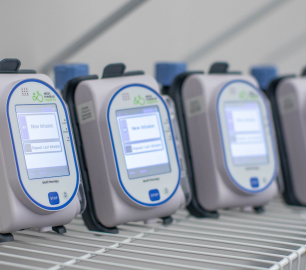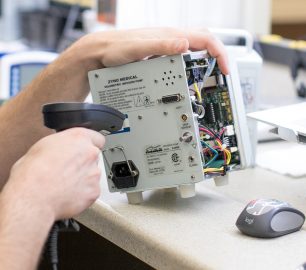The NICE Experience
To say we had a “NICE” time in Miami for the National Infusion Center Association Annual Conference would be an understatement.
See what we did there?
In case you didn’t pack your bags and head south during the start of summer, we’ve recapped the most misunderstood items showcased in the National Infusion Center of Excellence (NICE) Experience.
What is the NICE Experience?
The NICE Experience featured a mock infusion suite at the NICA 2023 Annual Conference showcasing products and services from leading industry players.
The purpose of the NICE Experience is to offer attendees a hands-on demonstration of exciting products in the market while displaying an ideal National Infusion Center of Excellence which adheres to the Standards of Excellence for Ambulatory Infusion Centers developed and endorsed by the National Infusion Center Association.
The Pink Fuzz.
We’ve all been there… Skipping the occasional shower or sink cleaning during a busy weekend. And then a few days later you see it – the pink fuzz around the drain or soap bottle.
It doesn’t take much to build bacteria in a sink drain.
And pending your sink design, you may be at higher risk for bacteria and mold to build and populate the air and counter space, ultimately affecting the cleanliness of your facility.
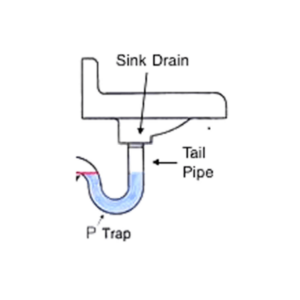
The Standard
(4.5.3) If the designated preparation area is within three (3) feet of a sink, a splash guard is required to help prevent microbial contamination and to provide a physical barrier between the preparation area and the sink.
The Solution
Meet splash guards. The clear, acrylic simply sits next to a sink blocking particles from spraying around your counter space and into your medication prep area.
Shop Splash Guards
A BREATH OF FRESH AIR.
How often does your facility run behind schedule?
The reality is it happens more often than we’d like to admit.
Oxygen should be on hand for medical emergencies, but have you thought about appointment delays? Some patients use oxygen at home and will arrive with their own portable oxygen tank, but if their appointment takes longer than they had planned, this could be a dangerous situation if their tank runs low or possibly even empty.
NICA Standards of Excellence do not require oxygen to be piped into the building through the walls like you see in hospitals, but they do require facilities to have oxygen available in case of emergencies.
The nominal cost is worth eliminating the risk of mismanaging patient care.
The Standard
(7.2.5) Reaction kit contents (i.e. medications, supplies, and equipment) include but are not limited to the following: Oxygen and delivery system or device (e.g. nasal cannula, non-rebreather mask).
The Solution
Keep a portable oxygen tank on hand. NICA recommends an e-cylinder from a local DME or medical gas supplier to meet this requirement. If you’re building a new infusion center, you can install piped oxygen into your walls – but that is not necessary.
PUMP IT UP.
Unfortunately, we’re not here to answer the age-old question of what’s the best infusion pump?
That decision is based on factors like the drug type, dose, rate, administration environment and potential adverse effects.
Some situations like hydration, may not require a pump at all and instead can use a flow-regulator or a dial-a-flow.
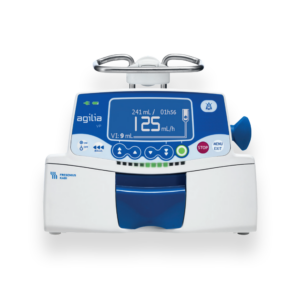
The Standard
(6.7.2) The use of non-electronic flow-control devices for low-risk infusion where some variation in flow rate is permissible.
(6.7.5) The use of an electronic infusion device for infusion therapies that require precise flow control for safe medication infusion administration.
The Solution
Lean on a consultative distributor to help guide you through your options. From pole mounted to elastomeric pumps, Right Way Medical is positioned to help you obtain the supplies you need with customized financing options.
Safety Circle.
It’s not uncommon for patients to bring guests to their infusion – either out of necessity or potentially to calm their nerves.
Clinicians know to proceed with caution with used sharps however other guests may be more ignorant to the risks. Curious children (and let’s face it, the potential curious adult) and service animals tend to be the hardest to control.
The Standard
(10.6.4) Sharps disposal containers with appropriate functionality (i.e. puncture resistant, durability, and appropriate closure), accessibility (i.e. easy to use, spill prevention), visibility (i.e. easy to identify/find, warning labels, fill status), accommodation (i.e. minimal training, easy to operate, safe, and cleanable).
The Solution
Secure sharps containers in all patient care areas as to eliminate the risk of clinicians walking away with exposed, sharp objects and sticking themselves or others.
From smaller wall-mounted containers to large floor securing sharps containers, all containers should be secured in an upright position with direct line of sight to the opening. Selecting the correct closing mechanism is also important to think through. Curious hands tend to find their way into open containers!
ON LOCK DOWN.
We challenge you to think outside of your normal clinical team on this one.
Who is around your medications outside of your clinical team? Who else has keys to your facility?
Common answers may be educational classes for newer faculty or maintenance and cleaning crews with rotating staff members, who don’t have education on drugs.
Do these individuals know saline is a prescription medication? Are they trained to clean medications they may accidentally knock over? The answer is likely no.
The Standard
(10.9) A safe and secure storage area for medication, medication preparations, supplies, and biohazardous material is provided.
The Solution
If you’d like to spend the resources, there are closed door securement devices for room temperature and cold medications.
A more cost-effective alternative is to add cabinet locks to cupboards and drawers. Keys should stay within your organizations’ safety protocol to stay monitored when not in use.
PROPER PREPARATION.
We recommend keeping chaos away from your medication preparation area. Creating a visual barrier for different preparation stations is a great cue for staff to keep areas tidy and sanitized.
Typically, a nonporous surface that can be disinfected works best.
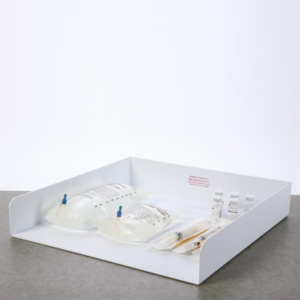
The Standard
(4.5) The organization ensures each facility has a designated area(s) for the preparation of parenteral medications. (4.5.1) Preparation activities are performed on a clean, dry, uncluttered, hard, non-porous surface that can be disinfected prior to use.
The Solution
Medication prep trays are a great reminder to keep the area clean and organized for med prep. In a busy office with limited counter space, papers can be laid anywhere, wrappers tend to stick around a little too long, or perhaps a shipping box from last weeks order of syringes can find its’ way onto your prep area.
A med prep tray marks a designated area for staff members to keep clean and clinicians to utilize.
We only clarified the top items people asked us about for their ambulatory infusion center but we’re happy to walk you though the rest!
The Right Way Team believes in the NICA mission to standardize processes and provide only industry leading products to protect patients and clinicians.
Accelerate your practice with the National Infusion Center Association’s Standards of Excellence for Ambulatory Infusion Centers here.
Connect With RWM NICA Standards
About The National Infusion Center Association
NICA is dedicated to ensuring that the nation’s infusion centers remain a safe, more efficient, and more cost-effective alternative to hospital settings for consistent, high-quality care.
Infusion providers have a vested interest in the sustainability of the infusion delivery channel and its ability to serve vulnerable patient populations. NICA Provider Members have a voice and a seat at the table to inform NICA’s activities and the opportunity to remain highly engaged in the expansion and optimization of the infusion industry. Learn more about becoming a NICA member, here.
